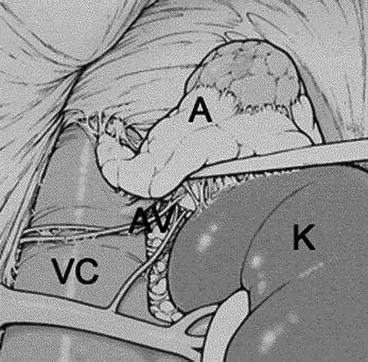Figure 7.1
Operating table modified to facilitate retroperitoneal approach
Required Equipment
Ports:
5 mm bladeless trocar × 2
10 mm disposable Balloon trocar (Autosuture)
5 mm bladeless trocar × 1 (optional)
Laparoscopic cameras:
10 mm 30° scope
5 mm 30° scope
5 mm 45° scope (optional)
Other Instruments:
5 mm LigaSure™ (Covidien Ltd, Mansfield, MA) or Harmonic Ultrasound Device® (Ethicon Endo-Surgery, Inc)
Laparoscopic Suction/Irrigation
Laparoscopic blunt grasper
Laparoscopic peanuts
EndoCatch™ (Covidien Ltd, Mansfield, MA) for specimen extraction
Insufflation
20–24 mmHg CO2
Port Placement
An initial 1.5–2 cm incision is made just beneath the tip of the 12th rib transversely and will be used for initial camera placement and specimen extraction. Using a combination of sharp and blunt dissection, the retroperitoneal space is entered. Using the index finger to clear retroperitoneal fat off the postero-medial border (paraspinous musculature) enables creation of a working space. This dissection then is carried to the superior-most extent of the operator’s reach medially and inferiorly until enough working space is created for placement of the camera port and the two 5 mm trocars. A 5 mm trocar is then placed 4–5 cm laterally and 2 cm inferior to the tip of the 11th rib angled appropriately to avoid collision with the rib during instrument manipulation. We insert a finger through the initial incision to guide the trocar into the working space and clear any overlying retroperitoneal fat. A second 5 mm trocar is placed at the medial border of the paraspinous muscles usually ~4 cm medial to the 10 mm trocar and 3–4 cm below the 12th rib angled to 45°. The balloon trocar is placed through the initial incision and CO2 insufflation is achieved to 20–24 mmHg. The surgeon and assistant typically stand on the same (ipsilateral) side of the target gland.
Procedure
Using the 10 mm 30° scope, additional working space in the retroperitoneum is first created using two peanuts/graspers in a sweeping motion. The paraspinous muscle is an important landmark that allows for appropriate orientation in the retroperitoneum, and is first identified and cleared as superiorly as possible towards the adrenal. Starting medially will also prevent entry into the peritoneum which lies laterally and near the plane of dissection particularly in thin patients. Entering the peritoneum during the dissection is suboptimal as CO2 insufflation into the peritoneal cavity can cause progressive reduction of the retroperitoneal working space as the peritoneal contents are displaced by the CO2. The superior border of the kidney is then identified as the retroperitoneal fat is swept away. The upper pole of the kidney is identified and Gerota’s fascia is sharply entered, aided by pushing the kidney down with the surgeon’s opposite hand exposing the adrenal gland. Freeing up the adrenal from the superior pole of the kidney is best accomplished at this point while the adrenal is still attached superiorly and medially. Rarely, if exposure is limited, a 4th 5 mm trocar may be placed inferior to the lateral port to retract the kidney during dissection of the inferior portion of the adrenal gland.
During right adrenalectomy, the adrenal vascular supply is encountered posterior to the vena cava. Further dissection of the medial aspect of the adrenal gland facilitates gentle lateral retraction of the gland and clear visualization of the IVC. The adrenal vein is then typically seen running posterior and lateral at 9–10 o’clock and may be clipped or doubly ligated with the coagulation device (Fig. 7.2). During left adrenalectomy the adrenal vein is encountered running medial to the upper pole of the kidney at approximately 4–5 o’clock and is clipped or doubly ligated with coagulation (Fig. 7.3). An accessory renal artery may be present and is usually located in the 6 o’clock position, and should be preserved. On the left, there is often a limb of adrenal that extends anteriorly and medially into the renal hilum. Care should be taken not to inadvertently transect the adrenal at this location.










